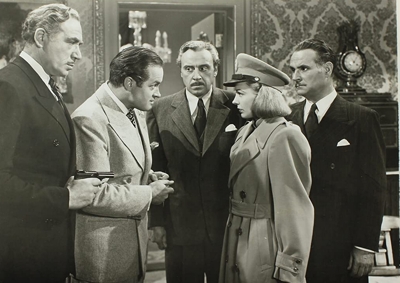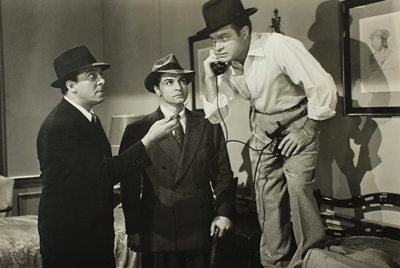
Grade: B-/C+
Comedy
Not rated (would be PG)
Throughout their careers, Bob Hope and Bing Crosby had a rivalry that extended beyond their onscreen personas in the “Road” pictures they made with Dorothy Lamour. In 1946, Crosby had the upper hand. His Bells of St. Mary’s was the top grossing film that year, while his Blue Skies placed #3, just ahead of their Road to Utopia picture. Meanwhile, Hope’s Monsieur Beaucaire lagged at #26.
A year later Hope made Where There’s Life and couldn’t resist a dig at both of them, as on-the-lam radio personality Michael Valentine (Hope) runs through a narrow street past a movie poster of Blue Skies and does a turned-up-nose double-take.
In fairness, Hope’s nose was always turned up, and that self-proclaimed “banana nose” was also a running gag from picture to picture. Where There’s Life is one of several Cold War spy comedies that Hope made, and it falls somewhere in the middle of the comedian’s film catalog. It’s pleasantly entertaining, but we feel as if we’ve seen it all before. I mean, how many times can you make a film about an innocent average Joe who gets caught up in intrigue and finds himself intrigued as well by a femme fatale?
As it turns out, three others—My Favorite Blonde (1942), They Got Me Covered (1943), My Favorite Spy (1951)—but it seems like more because there’s not enough variation to the plots. You begin to realize as much when you find yourself delighted by little things in the film—like that Blue Skies dig or William Bendix, who plays a cop in this one, saying “What a revoltin’ development this is!” Audiences familiar with The Life of Reilly radio series starring Bendix would have laughed to hear him repeat his famous catch-phrase, one he’d continue to use as Reilly on the TV sitcom version in the fifties.
Where There’s Life was billed as a thriller-comedy, but contemporary audiences won’t find many thrills or scares here. It’s the usual Hope light entertainment, with a premise that starts out promising but then settles back into that comfy overstuffed chair of on-the-lam pursuit. At least this time there’s no mistaken identity. Radio announcer Michael Valentine is the heir to the recently assassinated King of Barovia (a fictional Soviet Bloc country). A clichéd “General Katrina Grimovitch”—a stern-looking stereotype played by Signe Hasso—is dispatched to find Valentine and bring him back. But before he can even warm to the notion of leaving the U.S., members of a secret society called the Mordia responsible for the death of King Hubertus II is trying to make sure Valentine never makes it onto a plane alive. You know: that classic tug-of-war the heroes often find themselves in.
Predictably an attraction develops between the General and Valentine, but it’s not developed enough to where we actually believe it. Then again, it’s hard to sell a romance when one character is as cardboard as can be, and when the guy is already in a longstanding relationship. That’s where Bendix comes in as the woman’s brother, a New York cop that, with all his buddies, has a different idea about where Valentine should be going and whom he should be seeing. When the smoke clears, though, it’s a template plot that’s not intended to be anything more. It’s typical Hope light entertainment, and especially in the first two acts it has its charms.
Hope is one of them. A scene where he’s imprisoned in a basement and attempts to escape is fun, as are his and the General’s initial adventures together. But in case you were wondering whether Hope scored better at the box office in 1947 than he did the previous year, the answer is no . . . times two. Where There’s Life finished at #35, while another Hope film, My Favorite Brunette, ranked as the #31 top grossing picture. But you can take those numbers with a grain of salt, because It’s a Wonderful Life only came in at #27, and that other holiday classic Miracle on 34th St. did worse than both Hope movies with its 45th place finish.
The bottom line is that if you like the light entertainment films from the forties and fifties and like Hope’s schtick, you’ll like Where There’s Life because it’s typical of the era and the star. As I said, it falls somewhere in the middle of Hope’s films. Fans will be glad to add it to their collections, and for that we can thank Kino Lorber for almost single-handedly giving us Hope’s catalog in high definition.
Entire family: Yes (though younger children might be bored)
Run time: 75 min. Black-and-white
Aspect ratio: 1.37:1
Featured audio: DTS Mono
Studio/Distributor: Kino Lorber
Bonus features: D (just the one trailer)
Amazon link
Not rated (would be PG for some violence and adult situations)
Language: 0/10—Nothing offensive here
Sex: 2/10—Some night clothes and two people sleeping in the same room (but not the same bed), and some mild, almost polite kissing
Violence: 4/10—The whole plot turns on people wanting to kill Valentine, so there are a lot of close calls but no serious violence
Adult situations: 3/10—Besides that hotel scene there’s some smoking, drinking (no drunkenness) and angry police (which very young children might misinterpret)
Takeaway: Hope fans know what they’re getting with a picture like this, and he doesn’t disappoint . . . even if it does seem like overly familiar ground that’s being covered





Leave a comment